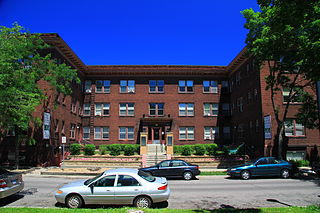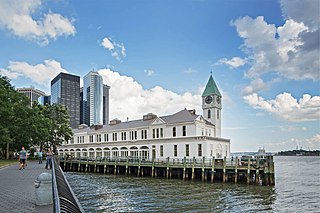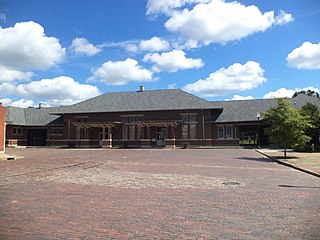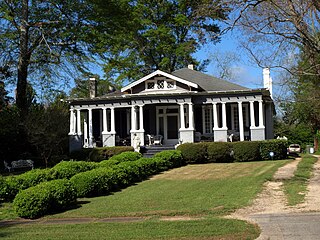
Cabbagetown is an intown neighborhood on the east side of Atlanta, Georgia, United States, abutting historic Oakland Cemetery. It includes the Cabbagetown District, a historic district listed on the U.S. National Register of Historic Places.

Jackson Ward, previously known as Central Wards, is a historically African-American district in Richmond, Virginia, with a long tradition of African-American businesses. It is located less than a mile from the Virginia State Capitol, sitting to the west of Court End and north of Broad Street. It was listed as a National Historic Landmark District in 1978. "Jackson Ward" was originally the name of the area's political district within the city, or ward, from 1871 to 1905, yet has remained in use long after losing its original meaning.

The Georgia Trust for Historic Preservation is the United States' largest statewide, nonprofit preservation organization with more than 8,000 members. Founded in 1973 by Mary Gregory Jewett and others, the Trust is committed to preserving and enhancing Georgia's communities and their diverse historic resources for the education and enjoyment of all.

Lincoln Park is a city square and neighborhood, also known as "the Coast," in Newark, Essex County, New Jersey, United States. It is bounded by the Springfield/Belmont, South Broad Valley, South Ironbound and Downtown neighborhoods. It is bounded by Martin Luther King Jr. Blvd. to the west, West Kinney St. to the north, the McCarter Highway to the east and South St., Pennsylvania Avenue, Lincoln Park and Clinton Avenue to the south. Part of the neighborhood is a historic district listed on the New Jersey Register of Historic Places and the National Register of Historic Places. Lincoln Park as a street turns into Clinton Avenue toward the south and north edge of the park.

Stevens Square is the southernmost neighborhood of the Central community in Minneapolis. Although one of the densest neighborhoods in Minneapolis today, the land was originally occupied by a few large mansions. Today, the area is composed mostly of old brownstone apartment buildings or mansions that have been subdivided into apartments, giving the neighborhood a heavy population density within its small geographical area; a short and wide neighborhood, it is nearly a mile long but only three blocks tall. Much of the neighborhood is a National Historic District, and five of the apartments were listed on the National Register of Historic Places in 1993.

The Railroad Cottage Historic District is an area originally comprising eight historic cottages along Casino Center Boulevard in downtown Las Vegas, Nevada. The eight cottages had once been part of a development of 64 homes constructed by the San Pedro, Los Angeles & Salt Lake Railroad to provide housing for their employees. Although a handful of cottages still existed at the time, only eight neighboring cottages were included in the district when it was created in 1987.

The C.H. Brown Cottage is a historic house at 34 Wright Street in Stoneham, Massachusetts. Probably built in the 1830s, it is a well-preserved example of worker housing built for employees of local shoe factories. It was listed on the National Register of Historic Places in 1984.

The New York Landmarks Conservancy is a non-profit organization "dedicated to preserving, revitalizing, and reusing" historic structures in New York state. It provides technical assistance, project management services, grants, and loans, to owners of historic properties. Since its founding, the conservancy has provided more than $40 million in grants and loans.
A Mississippi Landmark is a building officially nominated by the Mississippi Department of Archives and History and approved by each county's chancery clerk. The Mississippi Landmark designation is the highest form of recognition bestowed on properties by the state of Mississippi, and designated properties are protected from changes that may alter the property's historic character. Currently there are 890 designated landmarks in the state. Mississippi Landmarks are spread out between eighty-one of Mississippi's eighty-two counties; only Issaquena County has no such landmarks.

Fourth and Gill is a neighborhood in Knoxville, Tennessee, United States, located north of the city's downtown area. Initially developed in the late nineteenth century as a residential area for Knoxville's growing middle and professional classes, the neighborhood still contains most of its original Victorian-era houses, churches, and streetscapes. In 1985, 282 houses and other buildings in the neighborhood were added to the National Register of Historic Places as the Fourth and Gill Historic District.

The Cottage Home Historic District is a historic district and neighborhood located on the near east side of Indianapolis, Indiana. A small portion of Cottage Home is listed on the National Register of Historic Places while a larger area is listed on the state and local levels. Known for its preponderance of "cottage-style" homes built with strong Victorian influences, Cottage Home has historically been a working class neighborhood. Numerous industrial buildings are also scattered throughout the district, providing a base of economic activity. Today, however, many of these buildings are vacant, providing a special challenge to preservation and urban renewal efforts.

The South Cherry Street Historic District is a historic district mainly located along the 100 block of South Cherry Street in Greenville, Muhlenberg County, Kentucky. The primarily residential district, which also includes properties on several neighboring streets, contains twenty-three buildings, eighteen of which are contributing buildings to the district's historical significance. The first house in the district was built in 1842 by Jonathan Short. Short was followed by several others in the 1840s and 1850s as Cherry Street became the favored neighborhood of Greenville's prosperous merchants. The early homes in the district were all designed in a vernacular Greek Revival style.

Albany Railroad Depot Historic District is located at the 100 block of West Roosevelt Avenue in Albany, Georgia, United States, and is governed by the Thronateeska Heritage Center, a 501(c)3 not-for-profit organization incorporated in 1974 for the purpose of historic preservation and science education in Southwest Georgia. The Heritage Plaza includes the Tift Warehouse, the Union Station depot, the Railway Express Agency building and Albany's last remaining brick street and is listed in the National Register of Historic Places (NRHP).

Thronateeska Heritage Center is a 501(c)3 not-for-profit organization incorporated in 1974 for the purpose of historic preservation and science education in Southwest Georgia. Thronateeska is located at Heritage Plaza, the 100 block of West Roosevelt Avenue in Albany, Georgia, United States.

The Poinsett Hotel, or Westin Poinsett Hotel, is a twelve-story, landmark hotel in downtown Greenville, South Carolina, one of the first skyscrapers in Greenville. Named for Joel R. Poinsett, Secretary of War under President Millard Fillmore, the Poinsett replaced an earlier resort hotel, the Mansion House, built in 1824. In 1982, the Poinsett was listed on the National Register of Historic Places. The hotel is a member of Historic Hotels of America, an organization sponsored by the National Trust for Historic Preservation intended to promote heritage tourism.

The Portsmouth Cottage Hospital was the first hospital built in the city of Portsmouth, New Hampshire. Opened in 1884, it was one of the first hospitals in New Hampshire, and it served as the city's primary hospital facility until 1986, when Portsmouth Regional Hospital opened. Its 1895 campus has been repurposed to house city offices and the police station, and a senior living facility. A portion of that facility, representing its oldest buildings, was listed on the National Register of Historic Places in 1996.

The Commerce Street Residential Historic District is a historic district in Greenville, Alabama. The district consists of four houses along Commerce Street, constructed between 1846 and 1895. They represent the final and last remaining residential construction on the town's main street.

The Fort Dale-College Street Historic District is a historic district in Greenville, Alabama. The district contains Greenville's oldest existing affluent residences, dating to as early as the 1850s. In the initial federal land sale following the Creek War, the area that became northwest Greenville was claimed by William Dunklin. Dunklin sold the claim to William Burnette, who began to parcel the land for sale and to give to family members. Burnette's daughter and son-in-law built a Corinthian-columned Greek Revival home in 1857. A few other pre-Civil War houses remain, and construction continued after the war, including a school building that was later converted into a house. Most of the early residences were large, and built in Greek Revival, Second Empire, and Colonial Revival styles. Beginning in the 20th century, bungalows and cottages on smaller lots began to emerge. One of the later constructions in the district is a Spanish Colonial Revival house, built in 1928.



















